NOT WHO YOU THINK THEY ARE:
A Profile of the People Who Attend America's Megachurches
by Scott Thumma and Warren Bird
Note: Due to the size of this paper, you may wish to
download a copy in .pdf* for easier reading and printing.
*Note: You must have the free Adobe reader
installed on your computer to read this file.
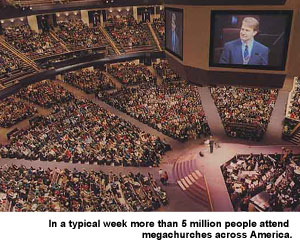
Have you wondered what it would be like to go to the nearest megachurch, sit down in one of their comfy chairs, get inside the mind of the congregation, and see their church as they do? You wouldn't be alone – in a typical week more than 5 million people attend megachurches across America.
So who are these folks? What attracts them and keeps them at these churches? And how do the attitudes and spiritual activities of these people compare with attenders in churches of other sizes?
Over the last 10 years we have learned quite a bit about U.S. megachurches, both the facts and fictions about these very large Protestant churches of 2,000 or more weekly attenders. However, until now, very little was known about those who attend these churches. This report summarizes the initial learnings from the first major national survey of megachurch attenders.
A FEW OF THE MOST PROMINENT FINDINGS:
- Young and single adults are more likely to be in megachurches than in smaller churches.
- Nearly two-thirds of attenders have been at these churches 5 years or less.
- Many attenders come from other churches, but nearly a quarter haven’t been in any church for a long time before coming to a megachurch.
- Attenders report a considerable increase in their involvement in church, in their spiritual growth, and in their needs being met.
- Forty-five percent of megachurch attenders never volunteer at the church.
- New people almost always come to the megachurch because family, friends or co-workers invited them.
- What first attracted attenders were the worship style, the senior pastor and the church’s reputation.
- These same factors also influenced long-term attendance, as did the music/arts, social and community outreach and adult-oriented programs.
- Attenders can craft unique, customized spiritual experiences through the multitude of ministry choices and diverse avenues for involvement that megachurches offer.
The National Survey of Megachurch Attenders was conducted January to August 2008 at 12 megachurches across the U.S..* It is the largest national representative study of megachurch attenders conducted by any researchers to date. Our research team surveyed the 18-year-old and older attenders of these churches at all their campuses and services during one weekend’s worship services. From this effort, we collected usable responses from 24,900 attenders out of a possible total of 47,516 people, for a 58% response rate. Additionally, we supplemented the survey at these churches with site visits, interviews, surveys of staff and other data collection efforts. The following material is organized around three major themes:
1. Who attends a megachurch,
2. Why they come,
3. And why some stay.
WHO ATTENDS MEGACHURCHES
The 12 churches studied were intentionally chosen to parallel the diversity among all U.S. megachurches as closely as possible based on the criteria of region, size, race, denomination, founding date, multi-site status and tenure of the senior pastor. The study is not intended to be a truly random statistically representative picture of all megachurch attenders; nevertheless, it represents the best and most accurate picture that exists at present of those who attend the nation’s megachurches. The sample slightly under-represents the western region of the country and is somewhat younger in terms of church founding date than the national profile of megachurches (see the table in the appendix for further details), yet we think it is as representative as a selection of 12 out of the nation's roughly 1,300 churches could be. Considerable variation exists among the 12 churches, but when the information is aggregated, the portrait closely parallels the authors’ experiences and previous research.
Throughout this report, when parallel information exists, we draw comparisons with a representative random sample survey of U.S. Protestant congregations of all sizes. These comparisons highlight where megachurch attenders are unique and where they are similar to churchgoers in other Protestant churches of all sizes. This comparison information comes from the U.S. Congregational Life Study (USCLS), a study completed in April 2001. The primary investigators were Cynthia Woolever, Deborah Bruce and others in the Presbyterian Church, USA research office. Our comparison uses only the subset of the USCLS attenders in Protestant churches who were 18 years or older (42,558 cases). Throughout the article we report comparisons between our megachurch attender information and the data from the attenders of USCLS Protestant churches of all sizes, unless clearly noted otherwise. Therefore, when the report and graphics use phrases such as “all U.S. churches” or "all churches" please realize that it refers to the random sample of 18 years or older attenders in USCLS Protestant churches of all sizes.

Comparing Megachurch Attenders to Folks in Other Churches
Broadly speaking, people who attend megachurches are mostly similar to the average churchgoer in smaller-size congregations. Both groups are predominantly female, well-educated, middle class, and married with children.
But if one looks closer at the information, significant differences emerge. Megachurches have larger percentages of younger people and singles; they are wealthier and have more education when compared to the random sampling of attenders of Protestant churches from the USCLS survey.
Considerably Younger
The average age of megachurch respondents is 40 years old, similar to the U.S. 2000 Census average. Yet, the average age of an attender in a typical congregation (USCLS study) is nearly 53 years old. Nearly two-thirds of megachurch attenders are under 45 years old, while only a third are for the all-size church sample (62% vs. 35%).
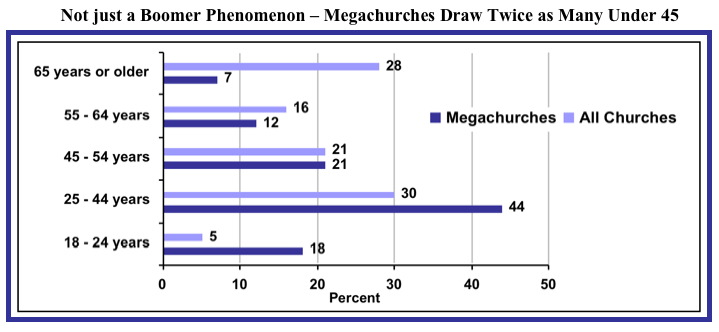
Many More Singles
Nearly a third of megachurch attenders are single, unmarried people. In a typical church, however, singles account for just 10% of the congregation. It is more likely in a typical congregation that the vast majority (80%) of attenders will be married or widowed. Yet in the megachurch attender sample these groups account for only 55% of the congregation. The vast majority of the megachurch singles fall into the 18-44 age range, a group that is essentially missing in many churches. Likewise, nearly half the singles in megachurches have been at the churches 2 years or less, but 20% of them have attended six years or more. Interestingly, these single attenders were twice as likely to be living with other singles when compared to churches of other sizes (16% vs. 8%) but equal in percentage for those living alone (16% vs. 15%). This suggests that perhaps a large percentage of the megachurch singles are students, a perception confirmed in our visits to the megachurches.
The visitors and newer people at the megachurches were even more likely to be youthful and single than were those to the average church. Almost 60% of single, never-married megachurch attenders are visitors or have been at the church 2 years or less, whereas for all churches 40% of never married people are visitors or are recent church attenders.
More Education and More Wealth
The average megachurch attender is somewhat more educated than representative church attenders and significantly more so than the general U.S. public. Over half of megachurch participants have college degrees or higher. Not surprisingly, given the increased educational levels, megachurch attender households were more affluent on average than churchgoers of the nation as a whole. Forty percent of megachurch attenders were at or below the 2000 U.S. median household income of $50,740 whereas nearly 50% of all churchgoing households were. Likewise, 26% of megachurch-attending families had an income of $100,000 or more while just 15% of all comparison churchgoers did.
Megachurches Have Higher Percentage of Attenders
Who are Single, Wealthy and Well Educated |
|
Megachurch Sample |
All Churches |
| Demographics |
|
|
Female |
60.5% |
61.5% |
Average Age of Attenders |
40 (2008 survey) |
50 (2001 survey) |
| |
|
|
| Marital Status |
|
|
Married, remarried |
53% |
71% |
Single, never married |
31% |
10% |
Widowed |
2% |
9% |
Separated, divorced, other |
14% |
10% |
| |
|
|
| Household Makeup |
|
|
Married couples with kids |
38% |
39% |
Couples no kids |
21% |
33% |
Single and living alone |
16% |
15% |
Several adults, same household |
16% |
8% |
Single parent with kids |
9% |
5% |
| |
|
|
| Education |
|
|
College graduate, post grad work or degree |
52% |
41% |
| |
|
|
| Household Income |
(describing 2007) |
(describing 2000) |
Under $50,000 |
39% |
49% |
$50-99,000 |
35% |
36% |
$100,000 or more |
26% |
15% |
A Tremendous Number of Newer People, But Not Many Brand New Christians
Over two-thirds (68%) of those attending a megachurch any given week have been there five years or less compared to 40% in churches of all sizes. This difference in "recent" participation doesn’t diminish even after removing the attenders of those megachurches founded within the past decade where more attenders would be newer by necessity.

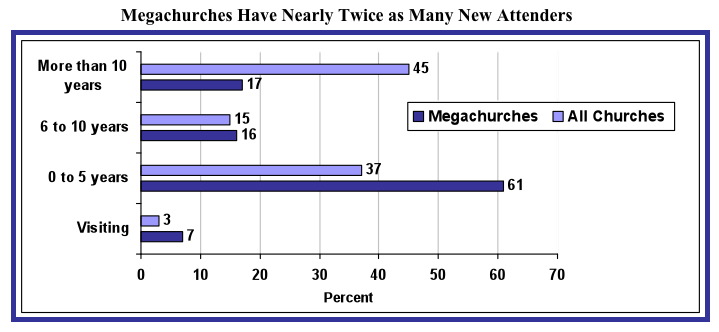
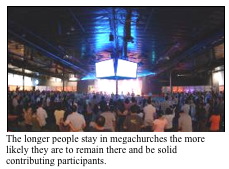 One might logically conclude that a large percentage of the new people are also new Christians. Certainly that is what many megachurch pastors proclaim. However, nearly everyone, including visitors, described himself or herself as a “committed follower of Jesus Christ.” We think many respondents interpreted this to mean, “do you consider yourself saved” given that barely 2% (roughly 500 people among the entire 24,900 survey respondents) said they were not a committed follower of Christ. Interestingly, of those respondents who were at these churches ten years or more, a handful (36 people or 0.1%) still described themselves as not being committed Christ-followers. One might logically conclude that a large percentage of the new people are also new Christians. Certainly that is what many megachurch pastors proclaim. However, nearly everyone, including visitors, described himself or herself as a “committed follower of Jesus Christ.” We think many respondents interpreted this to mean, “do you consider yourself saved” given that barely 2% (roughly 500 people among the entire 24,900 survey respondents) said they were not a committed follower of Christ. Interestingly, of those respondents who were at these churches ten years or more, a handful (36 people or 0.1%) still described themselves as not being committed Christ-followers.
Additionally only 6% of attenders said that they had never attended services prior to coming to their current megachurch. Therefore, it is clear that the majority of megachurch attenders are not necessarily new to Christianity. But it is equally evident that many of them are new to their megachurch – its culture, vision, routines and congregational community.
This task of orientation and assimilation of new people into the church’s culture and routines is a daunting one for megachurch leadership. It is not surprising that many megachurches expend considerable energy and resources on their education and discipleship efforts. New people are more likely to be marginal participants, attending more sporadically, giving less and volunteering infrequently. But the longer people stay at the churches the more likely they are to remain there and be solid contributing participants. Thus for megachurch leaders, the challenge is two-step: assimilate the masses of new people into the congregation quickly in order to retain them as long-term active participants.
Another Challenge – Multiple Loyalties
There was a time when church participants were members of only one congregation. Switching, when it occurred, happened serially – a person moved loyalty and participation (and hopefully official membership if church rolls were being well maintained) from one church to the next. This may no longer be true for all congregations’ attenders but it is certainly no longer descriptive of many megachurch attenders.
When megachurch participants were asked if they considered this church their “church home,” just three quarters said this was their only home church. Eleven percent of those in the pews didn’t consider this their home church (yet only 7% said they were visiting). Likewise, 12% claimed the megachurch as “home” but said they also attended other churches as well. Therefore, almost a quarter of those in worship any weekend have divided loyalties to the church they are in. 
Having Multiple Church Homes Leads to a Decrease in Active Participation
These divided loyalties make a considerable difference in how committed the attenders are. If attenders have a church home other than the one they attended for the survey or claim to have multiple homes, they are far less likely to attend, give, volunteer or invite others than do those who say this congregation is their only church home.
Spectators or Participants?
Another reality among attenders is that of the distinction between the participants and the spectators in the life of the megachurch. The majority of respondents claimed weekly or nearly weekly worship service attendance. While these attendance figures were less than for churches of all sizes, nevertheless roughly 90% of both groups claimed quite regular participation in worship services.

Another way the commitment level of attenders can be measured is by their participation in the life of the church – by how much they volunteer, give, participate in groups and invite others to the church. Not all of the megachurch attenders are equally active participants based on these measures. Nearly 45% say they never volunteer.
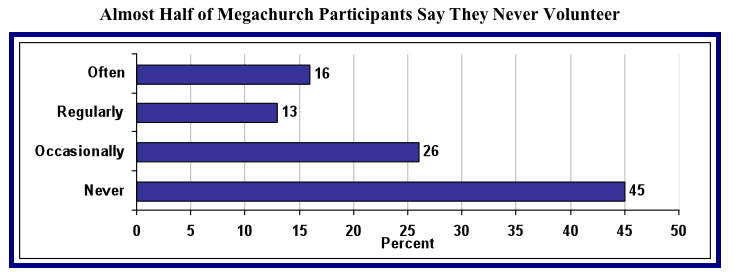
Additionally, 32% of megachurch attenders give nothing financially, or just contribute a small amount when they can. It is interesting that a third of both groups say they give a tithe or more. Overall, however, the megachurch giving figures are significantly below those for all churches generally. This may in part explain why in our other national research we found that megachurches apparently see a need to preach more about money than do smaller size churches.
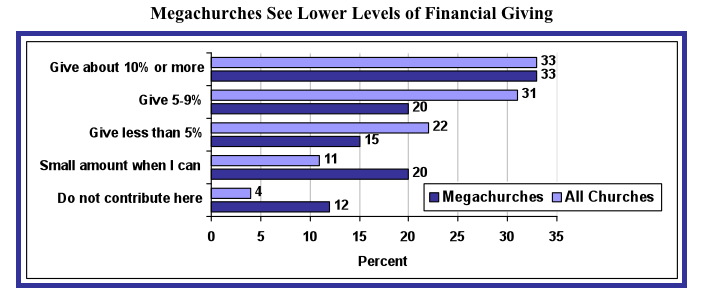
Even one of the mainstays of megachurch programming -- participation in small groups of different sorts -- is engaging only 60% of attenders. Forty percent of attenders said they do not participate in any small group. This is interesting given that in our national research the percentage of megachurches saying small groups are central to their functioning rose dramatically in less than a decade. In 2000, just half (50%) of the megachurches said small groups were central to their strategy for Christian nurture and spiritual formation. By 2008, that number had risen to 84% of megachurches affirming the centrality of a small group strategy. Yet, this increased emphasis on small group ministry does not appear to have motivated a large percent of attenders to active involvement in these groups.

Likewise, no particular type of small group garners more than 28% of attenders. Religious education and spiritual growth groups attracted approximately a quarter of megachurch attenders, while service, recovery and fellowship type small groups accounted for no more than 10% to 20% of attenders.
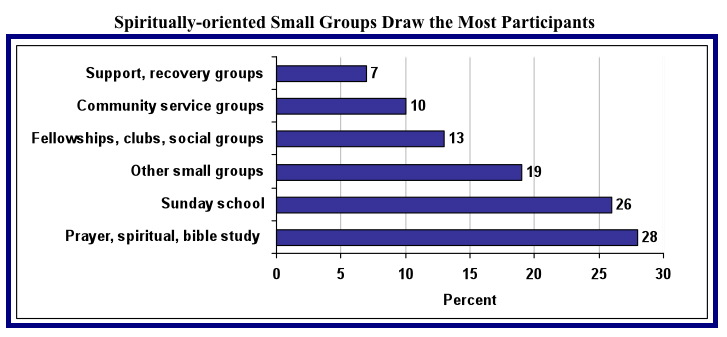
These findings do not necessarily prove that megachurches are doing an inadequate job of creating a congregational culture that fosters involvement. The picture is more complex than two independent groups in the church—involved participants and the detached spectators. This nuanced reality can be seen clearly among the very least involved in megachurches. Roughly 4,500 attenders (18% of the entire survey) indicate they don’t volunteer, attend small groups, or say they are active participants. Yet, a quarter of this group give generously and practice personal devotions daily, 28% have attended for 3 years or more, nearly 40% attend worship weekly, half consider this their church home and 75% have been Christ-followers for 7 years or more and have invited others to the church. Thus even the marginal participants are hardly uninvolved spectators.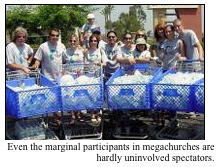
What these statistics do seem to indicate is that different participation dynamics might be at play in the megachurches. Clearly there are diverse interaction patterns in those who are drawn to a megachurch. In essence, these findings suggest that many participants are interacting with the megachurches on their own terms, to meet their own individualized needs. It has long been suggested by researchers that church attenders shop around to find a place that best meets their spiritual needs. Megachurches offer a multitude of choices and diverse avenues by which this can happen. As such, involvement at these (and perhaps all) churches may be less about creating an idealized plan to move someone toward commitment and more about providing many ways by which people could craft their unique, customized spiritual experience to meet their needs.
Personal Spiritual Life
These varying degrees of involvement in groups, giving, volunteering and small groups do not necessarily translate into a lack of personal spirituality. As noted above, the vast majority of attenders said they were committed followers of Christ, with over three quarters of them having been committed Christ-followers for seven years or more.
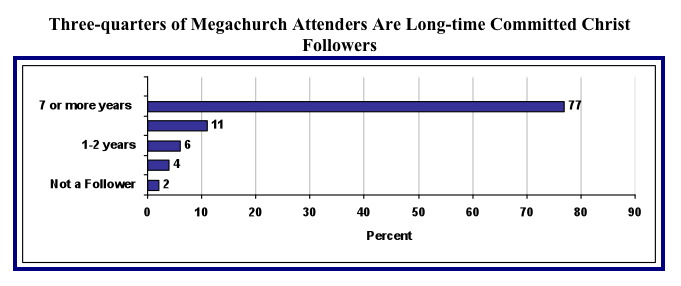
Megachurch participants also are engaged in personal Bible reading and prayer at considerably high levels, with nearly three-fourths of them saying they to do this daily or often during the week.

When these attenders were asked how much their faith had grown in the past year, 62% of megachurch participants experienced much spiritual growth, with 42% attributing that growth directly to their involvement in the church. The megachurches fare slightly better when compared with churches of all sizes, where only 58% of attenders claim much spiritual growth, and 39% attributing that to their churches directly. 
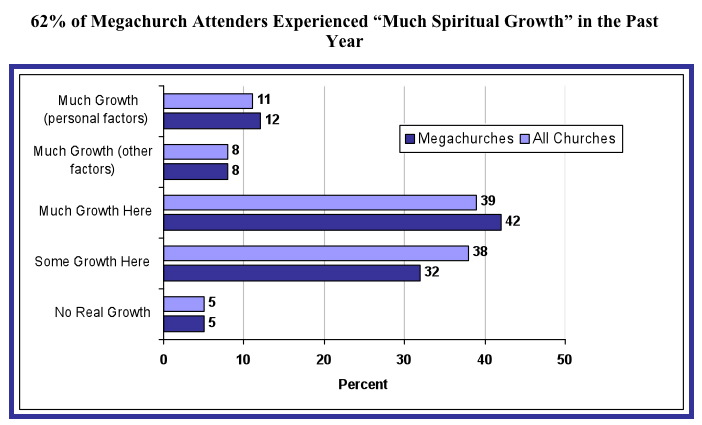
When this finding is looked at across the length of time that attenders are involved at the megachurch, a slightly different pattern is evident. Much as Willow Creek’s Reveal study (www.revealnow.com) found initially, those who have been at the churches more than 10 years had different spiritual growth patterns from those of newer attenders.
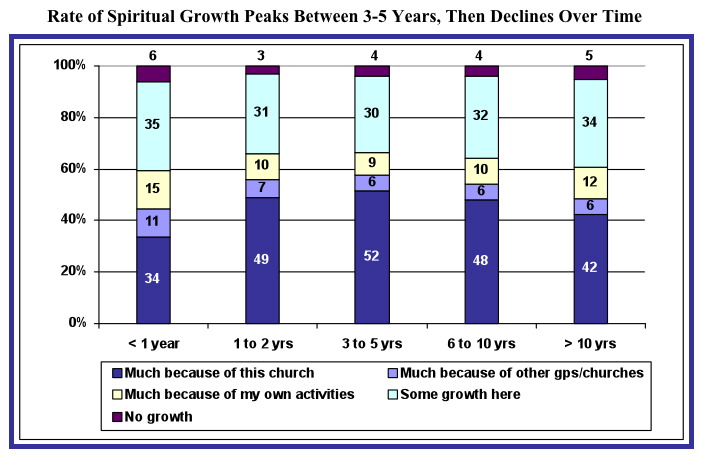
Another, perhaps even more subjective, way of measuring the spiritual growth of megachurch attenders was to ask them how satisfied they were with their spiritual growth. While many personal motivations, feelings of inadequacy or perfectionist ideals could play into this self-evaluation, nevertheless just 14% felt a level of dissatisfaction with their spiritual growth at the megachurches.

No matter what their level of satisfaction with their own spiritual growth, the question can be asked if the megachurches are addressing the spiritual needs of attenders. On this issue, a considerably high percentage of attenders strongly agreed that their spiritual needs were being met (45%) when compared to responses from churches of all sizes (38%). Interestingly, the megachurches also had larger numbers of attenders for whom their needs were not being met or were neutral about the issue. However, churches of all sizes were most likely to have attenders who chose a middle level of enthusiasm, somewhat agreeing that the church was meeting their spiritual needs.
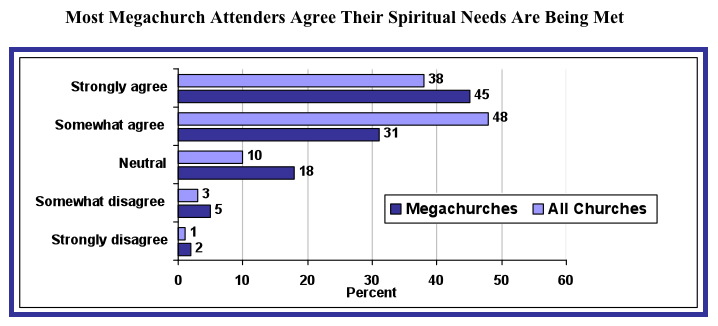
Perhaps an even better measure of their spiritual fulfillment in direct relation to the congregation is their rate of inviting others to the church. Generally speaking, if church attenders do not feel enthusiastic about their church or their spiritual experience at that congregation, they are less likely to invite others to participate. Thus, the rate of invitation of others by megachurch attenders suggests greater appreciation of the worship experience than do several of the findings above. Even among those who claimed a complete lack of involvement in groups, giving, or volunteering opportunities, a large percentage still invited others to the church.
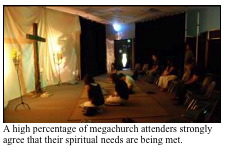 While no direct comparison exists on this question, the USCLS survey did ask attenders if they “would be prepared to invite any of your friends to a worship service.” Fifty-seven percent said, “Yes, they had within the past year.” Another survey of mostly mainline Protestant churches asked a similar question about how many people attenders had invited in the past year. In that study 45% of attenders said they hadn’t invited anyone in the past year, 38% invited 1 or 2, and 17% invited 3 or more people. Clearly there is something happening at the megachurches that the vast majority of attenders want to share with their family and friends. While no direct comparison exists on this question, the USCLS survey did ask attenders if they “would be prepared to invite any of your friends to a worship service.” Fifty-seven percent said, “Yes, they had within the past year.” Another survey of mostly mainline Protestant churches asked a similar question about how many people attenders had invited in the past year. In that study 45% of attenders said they hadn’t invited anyone in the past year, 38% invited 1 or 2, and 17% invited 3 or more people. Clearly there is something happening at the megachurches that the vast majority of attenders want to share with their family and friends.
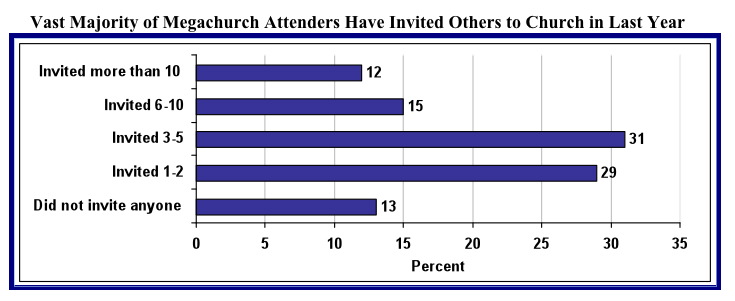
WHY THEY COME
It should not come as a surprise, based on the immediately preceding comments, that a majority of megachurch attenders (82%) come at the invitation of a friend, family member or co-worker.
Just under 20% of attenders found the megachurch of their own accord, either as a result of just seeing the church or viewing media about the church.

Likewise, even in this world dominated by Internet technologies, only 16% of attenders said they looked at the websites of these megachurches prior to attending physically. This is somewhat surprising given that most research on Internet use shows that people with the demographic characteristics of megachurch attenders are the most prolific users of the Web. Additionally, the websites of nearly all megachurches are well designed, have robust content and are of high quality.
Perhaps the seeming lower influence of the megachurch websites on bringing visitors has to do with the churches’ notoriety and very large presence in the community; essentially, it isn’t necessary to look at their websites since the local community already knows about them. Some evidence for this conclusion can be found in the fact that those coming to the church from a distant area, the transplants, are the most likely to have looked at the website prior to coming. It is also true that both the younger age of megachurch attenders and their length of time at the megachurch (two variables that are highly correlated) increase the chances that people have looked at the website before attending. Nevertheless, these findings again reinforce the important and significant power of personal invitations, even in the era of the Internet.
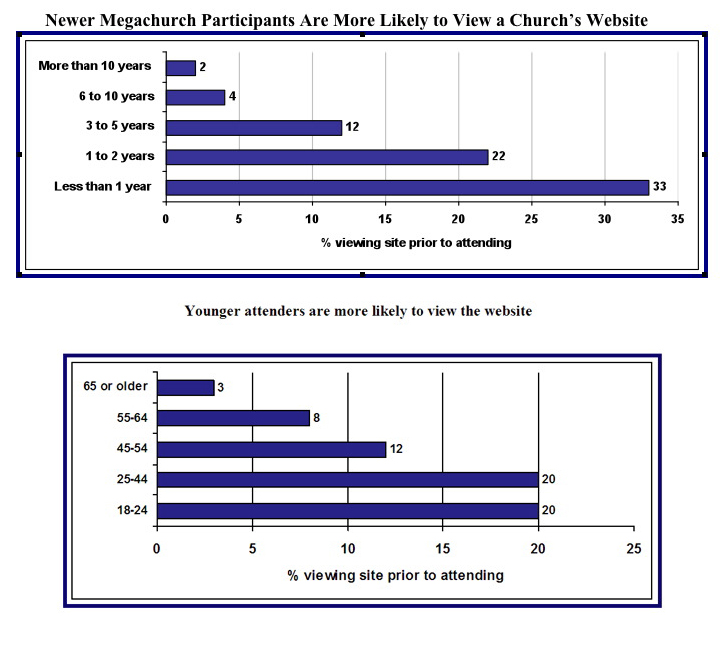
If a personal invitation from friends and family is the way most people find out about a megachurch, what is it that actually attracts them to the church? Somewhat surprisingly, it is not necessarily the strength of that personal relationship, but rather it is the more reputational and stylistic characteristics that attract them to the churches. The survey asked megachurch attenders to score a series of 10 items on a 1 (not at all) to 5 (a lot) scale on how influential each factor was in initially attracting them to come to the church. The worship style, senior pastor and reputation of the church were most strongly influential in initially bringing people into the megachurches. A secondary level of influence was attributed to music and arts, the presence of one’s family and friends and the church’s social and community outreach. An exception to this general pattern was if the person was a visitor or a recent attender of 1 year or less. In that case, the friends and family characteristic is an equal primary initial attraction, but it still doesn’t have a greater influence than the three most influential items. It is interesting that an often-stated reason for switching churches – that of the children’s and youth programs – rated very low even though most megachurches, including the 12 churches researched, had excellent youth programs. These programs were more attractive for couples and single parents with children, yet even for these groups youth programs were not the draw one might expect.
So what can be made of these findings? Clearly, most people coming to a megachurch need a direct personal contact with someone they know but it is the public image and their first impression of the church (shaped by the worship style, the personality and quality of the senior pastor and the church’s reputation) that potential, permanent participants find most appealing. This is followed secondarily by more programmatic characteristics, activities, amenities and the presence of their friends.
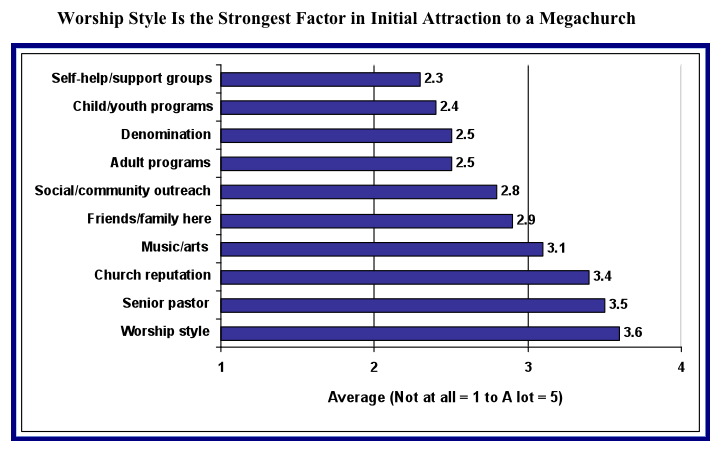
The average megachurch in our 12-church field study had 3,900 attenders weekly. Combining this level of attendance with the fact that only 4% of these attenders claimed to have been at their church all of their lives means that the vast majority of megachurch attenders were attracted to these largest congregations rather than grew up within them. This is as true for those churches founded many decades ago as it is for the less-than-10-years-old megachurches. Additionally, nearly all of the nation’s megachurches grew to their considerable size within the past 40 years. Therefore, this situation of relatively few cradle members makes sense. This reality is further reinforced by the fact that most megachurches are also located in developing suburban locales that are likewise less than 4 or 5 decades old and are filled with mobile, highly transient suburbanites. And 60% had been at the church less than 5 years. So then, where do all these people come from?
Are Megachurch People Stolen or Saved?
The story line from people critical of megachurches is that they are robbing smaller local churches of all their people. Critics point out that overall the number of Christians isn’t growing and the Christian percentage of the population is in decline, thus megachurches are at best recycling the saints, so to speak, by consolidating them into larger congregations. On the other hand, megachurch leaders often tout that they are highly successful at converting a large percentage of nonbelievers, adding many new Christians to God's Kingdom. The National Survey of Megachurch Attenders found that the truth lies somewhere between these extremes and is more nuanced than either side acknowledges.
We asked megachurch attenders if they were participating in another church immediately prior to coming to the church. As mentioned above, roughly 6% of attenders said they never attended any church before. The national data on all sizes of churches claimed 5% of attenders were formerly unchurched. The percentage of formerly unchurched did vary somewhat across the 12 churches examined, ranging from a high of 9% to a minimum of 3%. Nevertheless, these percentages are far below what might be expected if megachurches brought in large numbers of unsaved people. 
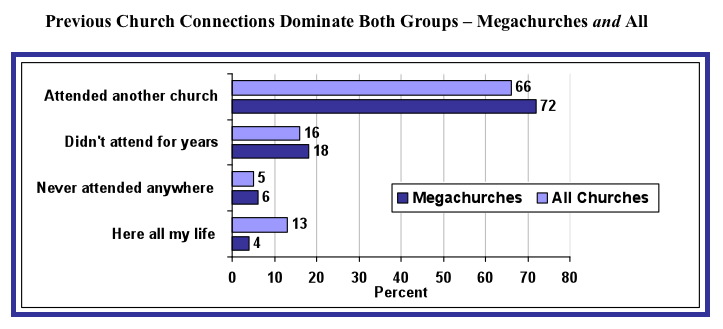
Churches
Another group of attenders that might count as reclaiming “the unchurched” in the minds of many clergy are those attenders who were not actively attending any church regularly for years prior to joining the megachurch. In other words, these people may have attended a church at one time but were not actively committed to one for years prior to their megachurch involvement. Their intensified participation could be understood as a spiritual conversion or re-dedication. Indeed, 18% of megachurch attenders said they hadn’t attended for years prior to joining. This is a slightly higher percentage than the 16% for churches of all sizes. This too varied considerably across the 12 megachurches, ranging from 10% to 28%.
If new converts and the formerly marginal participants were combined, then roughly a quarter of megachurch attenders could legitimately be identified as having been recently brought “into the fold.” This is a significant number (roughly over 900 people in an average-size megachurch) but it is only a few percentage points higher than all other churches, thus this can’t entirely account for the tremendous growth rates seen at most megachurches.
Three-quarters of megachurch attenders come from other established churches, a figure just 6% higher than all-size congregations. This finding conforms to what other researchers have noted, much of the growth for any size church results from trading attenders between churches (and internal birth rates). Our survey asked a further question of those megachurch attenders who came from a congregation immediately prior to joining. The question was whether the previous church was local, in the immediate area of the megachurch, or in a distant locale, meaning they relocated and then looked for a new church. This is significant to the question of wooing away current attenders of other churches since these distant transplants (students, job relocation, “snow birds” to the area on extended vacations, etc.) could not rightly be considered “stolen sheep” from some other congregation’s flock. Additionally, the integration of new transplants into a suburban context is one of the roles at which the megachurches are exceptionally adept.
Less than Half of Megachurch Attenders Came from Another Local Congregation
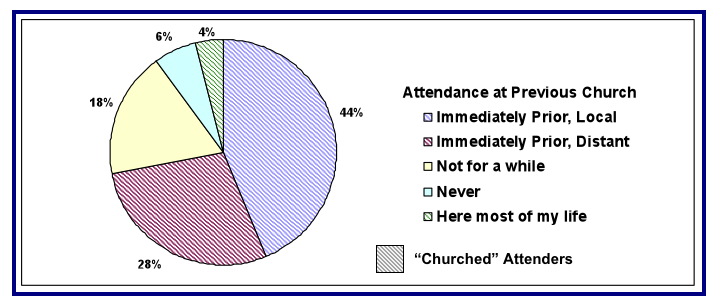
Indeed this nuance tells a slightly different story. Twenty-eight percent of all attenders (roughly 40% of the churched attenders) are transplants into the area from a distant location, while 44% of the megachurch attenders (60% of the churched attenders) did indeed come to the megachurch from other local churches. This percentage of straying sheep varied considerably across the churches studied, ranging from 30% to 55% of the congregations’ attenders. Thus, it is clear that many of the attenders of megachurches did come from other local churches, but this does not account for even half the attendance of these large churches.
WHY SOME STAY
Not everyone who visits or even attends a megachurch for a season will remain there. Among megachurch pastors, it is common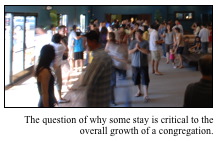 knowledge that the revolving door streaming new folks into the church also streams some of them back out. Thus, the issue of retention, the question of why some stay, is critical to the overall growth of a congregation. This is a far more complex issue than can be adequately tested with a one-time questionnaire. Nevertheless, the survey asked megachurch attenders to rate a series of 10 items for how influential each factor is in keeping them at the church presently – the same items listed previously for what initially drew them to church. We also used the same scale of 1 (not at all) to 5 (a lot). knowledge that the revolving door streaming new folks into the church also streams some of them back out. Thus, the issue of retention, the question of why some stay, is critical to the overall growth of a congregation. This is a far more complex issue than can be adequately tested with a one-time questionnaire. Nevertheless, the survey asked megachurch attenders to rate a series of 10 items for how influential each factor is in keeping them at the church presently – the same items listed previously for what initially drew them to church. We also used the same scale of 1 (not at all) to 5 (a lot).
Every item on the scale increased in intensity (garnered a higher score) from the question of what first attracted them. Therefore all 10 characteristics have some role in keeping a widely diverse grouping of attenders at the megachurch. Each characteristic garnered at least 20% of attenders who said it was highly influential in keeping them at the church. This is important to keep in mind: attenders are attracted and kept on the basis of a matrix of influential characteristics that vary considerably depending on individuals’ needs, interests and relationship to the churches. There is no single formula or programmatic plan that creates commitment across the board for all of the attenders.
With that in mind, those characteristics that are most influential for the largest percentage of attenders are indeed the same three items that initially attracted them to the church – the senior pastor, worship style and church reputation. Note, however, that the role of senior pastor moves to most important for 65% of the attenders, up from most important for 44% of them initially. This factor, along with social/community outreach and adult education, increases in influence by nearly an entire point on the point scale. These increases were followed closely by considerable gains in worship style and music and arts.
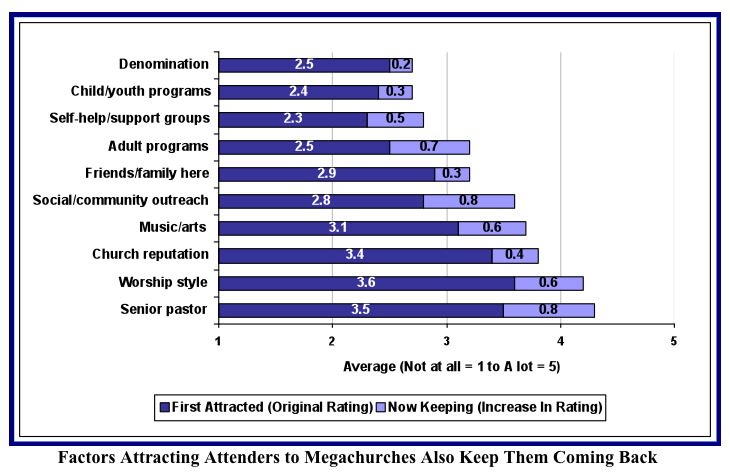
Megachurch leaders clearly want attenders to do more than just show up. Everything about these large churches is designed to encourage, entice, and even cajole spectators into active participation. The survey explicitly asked attenders what action moved them from being a passive spectator in worship to an active participant, what method encouraged them to finally get involved. Not surprisingly, given the earlier findings, nearly a third of attenders said they were not active participants. Visitors and first year attenders clearly populate this group, but also, as seen above, some long-time attenders come to worship services and do little else. 
A full 70% of survey respondents, however, identified themselves as “active participants.” Among those who claimed to have become active in the church, no single pathway to participation was responsible for channeling more than 20% of the attenders into an active situation. It is clear that different pathways appealed to and worked best for different people. The two paths to participation that corresponded to the most robust involvement in terms of volunteering, giving, small groups and spiritual development are those that were the most intrinsically motivated – taking the initiative oneself and sensing an inward sense of call. The newer and younger attenders were most likely to respond to a personal invitation from someone they knew. However, over the length of time at the church, this path to involvement produced less robust involvement than many of the other paths. Older and longer tenure attenders were more self-motivated and also more likely to respond to generic requests from the pulpit or from people they didn’t know. This is even more interesting when one considers that in response to a similar question, the staff of these churches almost entirely selected “general announcements”, such as from the pulpit or in a worship folder, as the main way they believe people become involved. What is clear regarding the movement toward commitment is that there must be multiple avenues since no single approach works for more than a small percentage of attenders.
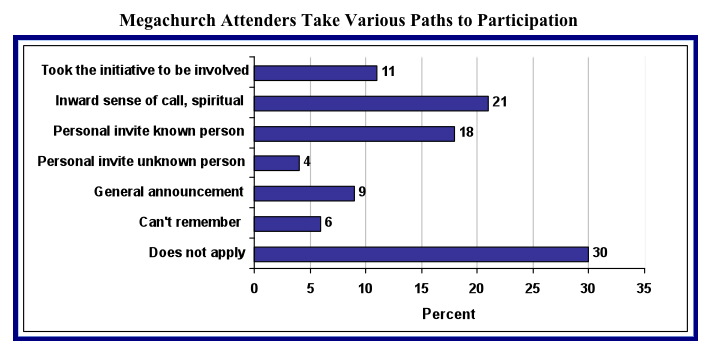
In addition to multiple paths toward involvement, megachurches have to make intentional, overt efforts to get attenders involved in the activities and life of the church. Over two-thirds of attenders agree their church is helping them to get involved.
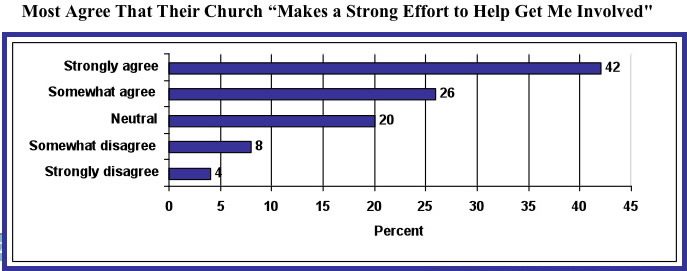
This effort includes constant calls for volunteers and preaching that encourages increased commitment. It also requires programs to discover and develop attenders’ gifts and skills. Roughly 60% of megachurch attenders agree their churches are doing this for them.
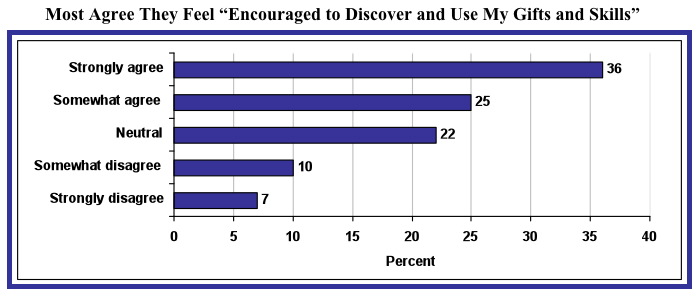
Likewise, given the considerable need for volunteer leaders within megachurches, there must be an emphasis on developing leaders from within the congregation. Nearly half the attenders strongly agreed their churches were assisting in this leadership development effort.
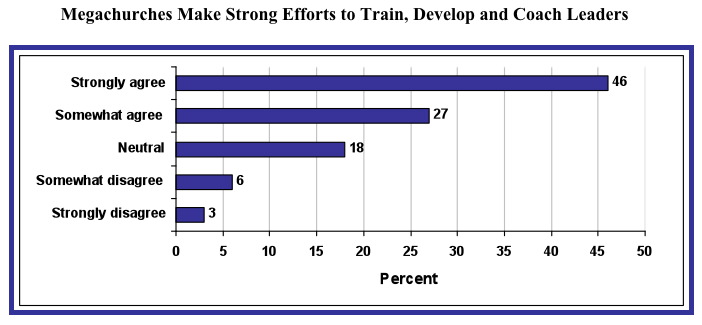
Nearly three quarters of attenders also agreed that the leadership is encouraging them to serve the wider community, nation and world. Thus, not only do megachurches encourage their attenders to become involved in the life of the church, but they are making efforts to help attenders develop gifts and talents, train them for leadership roles and encourage them to serve the wider community outside the walls of the churches.
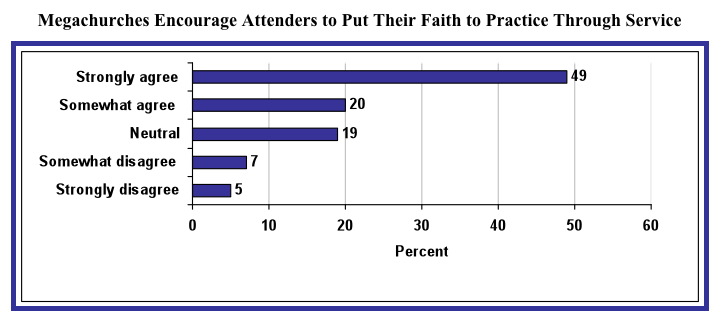
It is also clear from the survey that a majority of attenders have a strong sense of belonging to the megachurches. In many congregations a sense of belonging is strongly related to having many friends at the church. This sense is partially true for the megachurches as well.
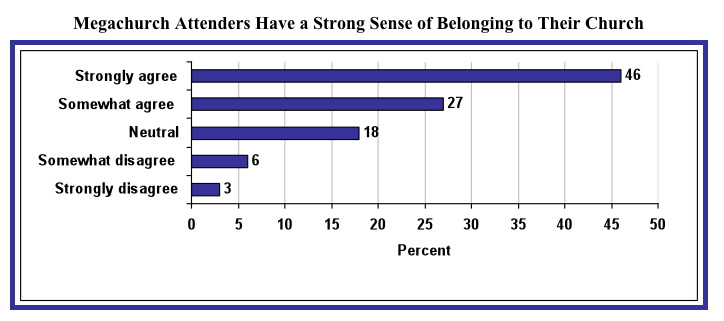
Nearly 55% of megachurch attenders who strongly agree they have a sense of belonging also have many close friends at the church. But, in many ways the megachurch is different in this than other churches. In these very large churches, many attenders have good friends but at the same time a large percentage don’t. Based on our conversations and observations, some people intentionally don’t want to establish friendships, even if they are highly committed to the church. Certain people come because they can be, and want to remain, anonymous.
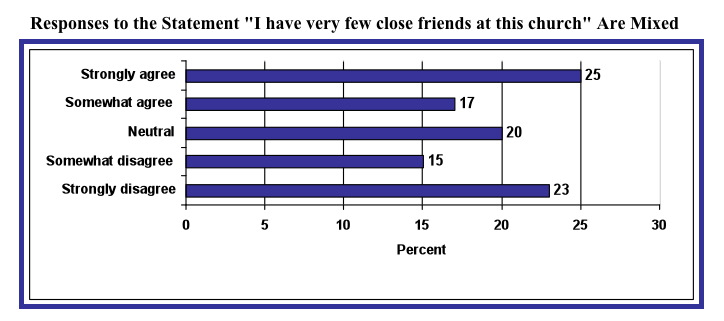
It is evident that the longer one attends a megachurch the more likely they are to have friends in the congregation. Nevertheless, almost a third of those at these churches over five years still report having very few close friends there. For some attenders even long-term participation in the megachurch is about something other than having a network of close friendships.
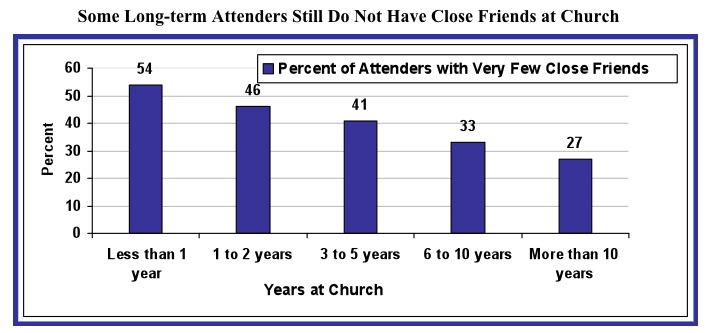
The correlation is strong between those attenders who report having close friends at church and those who are more involved and highly committed in any number of ways. Yet, the cultivation of friendships is not a goal for all those who attend a megachurch.
Intensifying the Religious Experience
Perhaps one of the clearer findings about participants in megachurches is that a large percentage report they have become more actively involved since coming. In other words, for a large group of participants the megachurches intensify both the religious experience and religious commitment. Nearly half of attenders who have been at their church longer than 2 years report that their involvement has increased, while less than 10% say it decreased.
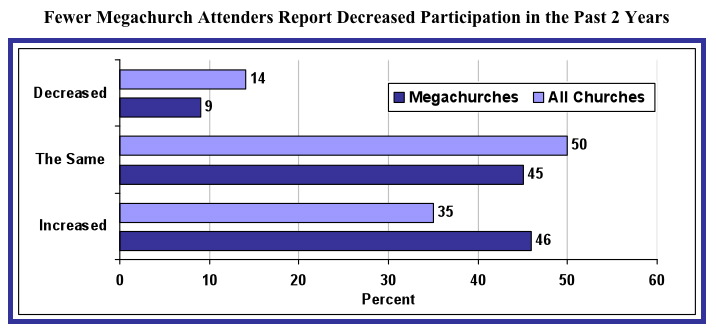
Attenders can also be seen to have intensified their commitment to giving since coming to the megachurches. When asked to compare their current giving level to that of their previous church, 40% claimed they were giving more. Giving was most likely to increase if attenders either hadn’t been to church in many years or had switched to the megachurch from another local congregation.
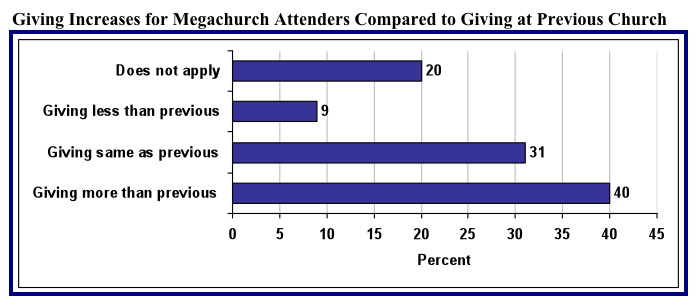
What Difference Does Going to a Megachurch Make Over Time?
Our survey is a snapshot of one moment in the lives of megachurch attenders so we can’t know the effects of long-time attendance on any one individual, but we can look at response patterns of different people by the length of time they have been there. A close look at several of the questions that allow for comparison between the megachurches and the sample of all church sizes show interesting differences over the time attenders are at these churches.

As we saw above, churches of all sizes have higher percentages of weekly worshippers. Those at the churches a longer time are more likely to be weekly worship participants, a pattern that is consistent for all size churches as well as megachurches.
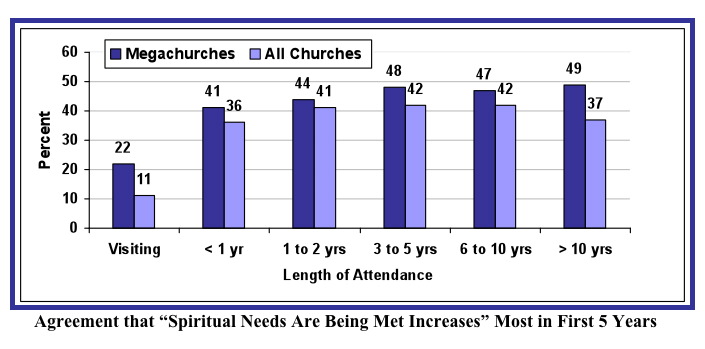
A slightly more surprising comparison results from looking at those who strongly agree their spiritual needs are being met. For the megachurches, the longer an attender has participated, the more likely they are to feel their spiritual needs are being met although the increase is very gradual after the first two years. For attenders in all sizes of churches, the same pattern is true until they are at the church 10 or more years. Interestingly, a smaller percentage of attenders at churches of all sizes strongly agrees that their spiritual needs are being met if they have been at the church more than 10 years.
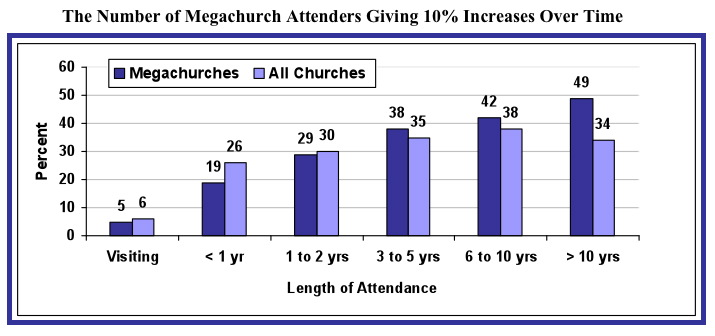
An examination of giving patterns for those claiming to contribute 10% of their income shows an even greater difference between megachurch and other attenders. By the time attenders have been at the megachurch 3 years or more a greater percentage are giving a tithe. This pattern continues throughout the later time periods in the two groups of churches, reaching a peak with half of the 10-or-more-years group in the megachurches tithing, compared to 34% of all-size churches. 

Likewise, the longer people attend the megachurches, the more likely they are to strongly agree that they have a strong sense of belonging. That finding seems intuitive; however, this increased sense of belonging or commitment and length of time at the church do not translate into ever-increasing levels of participation either for the megachurches or the other size churches.
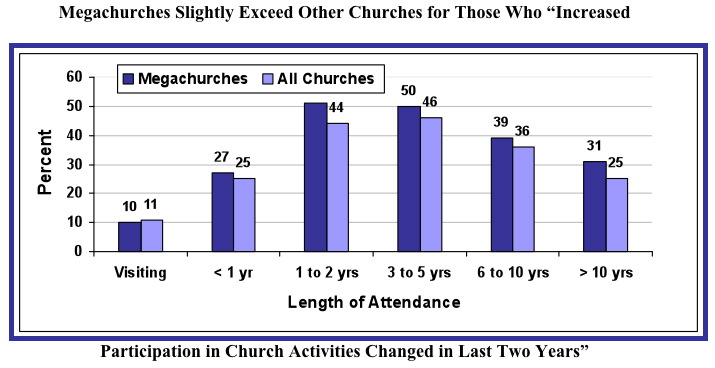
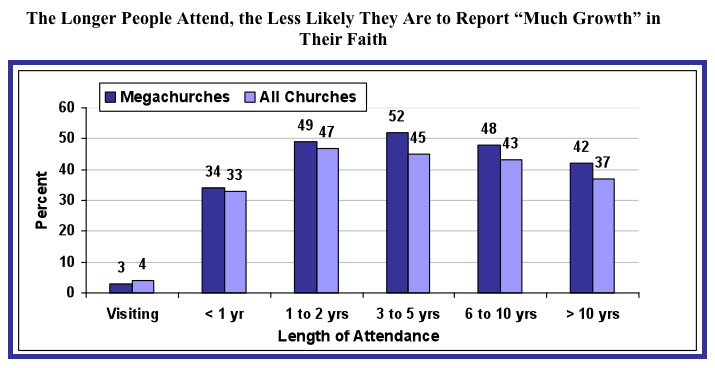
The percentage of attenders in either group peaks between one to two years for churches of all sizes and three to five year period at megachurches and then begins to drop off. The longer attenders are at the churches the fewer that claim high levels of spiritual growth in the previous year. Nevertheless, the megachurches show higher percentages in nearly every time period.
CONCLUSIONS
This initial glimpse into the spiritual lives of megachurch attenders offers many patterns to ponder. Certain facts are quite pronounced regarding this large group of megachurch attenders:
A Distinct Group of People
Megachurch attenders look quite different from people in a church of smaller size in many ways. Megachurch attenders are younger and more of them are single. This is especially true of those most recently attracted to these large congregations. Additionally, they are more educated and wealthier. Likewise, there are far less long-time attenders at megachurches than at the national sample of Protestant churches of all sizes. On the other hand, two-thirds of megachurch attenders have been there 5 years or less. Each of these characteristics brings with it both opportunities and challenges for churches.
Complex Patterns of Involvement
Individual involvement is also distinctive in most megachurches. Many attenders come from other churches, but nearly a quarter hadn’t been in any church for a long time before coming to the megachurch. Attenders report a considerable increase in their involvement in church, spiritual growth, and needs being met at the megachurch after coming. Yet, 45% of megachurch attenders never volunteer at the church, 41% don’t participate in small groups and over 30% give very little money. So, while everyone participates in the worship gathering at high levels, the reality of how individuals are involved in small groups, in diverse ministries, in leadership, in volunteering, and in personal spiritual practices is quite complex. Even those least involved people show odd patterns of connection to some aspects of the church and avoidance of others. Participation in these large-scale congregations is not an either/or proposition. Attenders have unique ways of connecting that may or may not look like the patterns in a typical smaller congregation.
Multiple, Well Traveled, Highly Public Paths into the Church
Evidence of this distinct megachurch pattern can be seen in the variety of ways people are attracted to and integrated into the church. While new people almost always come to the megachurch because a family member, friend or co-worker asked them, the attractional pull comes from many sources. For a majority, the most attractive characteristics included the worship style, the senior pastor and the church’s reputation but all the qualities were scored most important by a sizable group of participants. Additionally, fewer people were initially introduced to the church by its website but that percentage is increasing. Also, most participants come from other churches, both near and far, but nearly a quarter had no prior church ties, or else had not been actively participating and discovered a pathway back to church involvement in these megacongregations. It is clear that megachurches have many different doors into the life of the congregation and certain groups of people use every one of those entrances.
Multiple and Diverse Channels into an Active and Engaged Involvement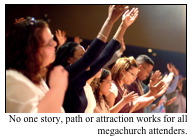
Not only are there multiple external doors into the megachurch, but also there are distinctive avenues into an active and engaged (as well as disengaged) involvement as a church participant. Many of the same factors that originally attracted folks also kept them attentive over the long term, but so did other characteristics – many of which became more critical than the originally influential attractions. And again, different groups of people resonated with different characteristics. This is also clearly seen in how the attenders said they moved from spectators to active participants, using many diverse paths or even none at all.
A Last Word…For Now
Despite all those contrasts, megachurch attenders are not radically different people from those who attend Protestant churches of all sizes. They don’t come to a megachurch and then develop into a different kind of spiritual being. However, the complex organizational structure, its multiple programs and abundant choices, and large scale social forms do create the possibility for interaction and involvement in ways that are different from smaller churches. This initial summary report begins to hint at some of those ways. Our forthcoming efforts will continue to explore how megachurch structures create new models of involvement and perhaps insightful lessons for churches of all sizes.
The percentage of attenders in either group peaks between one to two years for churches of all sizes and three to five year period at megachurches and then begins to drop off. The longer attenders are at the churches the fewer that claim high levels of spiritual growth in the previous year. Nevertheless, the megachurches show higher percentages in nearly every time period. 
Project Directors and Authors

Scott Thumma (Ph.D., Emory University) is Professor of Sociology of Religion at Hartford Seminary's Hartford Institute for Religion Research and Director of Distance Education. His latest book, Beyond Megachurch Myths (2007), debunks many of the false assumptions about megachurches. Contact Scott at sthumma@hartsem.edu.

Warren Bird (PhD, Fordham University) serves as a primary researcher and writer for Leadership Network and has more than ten years of church staff and seminary teaching experience. He has collaboratively written 21 books, all on subjects of church health or church innovation. Contact Warren at warren.bird@leadnet.org
Background of the Study
The 2008 research study was jointly conducted by Warren Bird of Leadership Network, Dallas, Texas (www.leadnet.org) and Scott Thumma of Hartford Seminary’s Hartford Institute for Religion Research (www.hartsem.edu).
During the first half of 2008, twelve megachurches were selected in an effort to typify the overall profile of America's roughly 1,300 megachurches (congregations with weekly worship attendance of 2,000 or more adults and children). As mentioned earlier, these 12 churches closely represent the national megachurch profile in terms of attendance, region, denomination, dominant race or multi-racial character, founding date, whether they crossed the 2,000 mark under the leadership of their present senior pastor, and whether they are multi-site. Information in the following tables describes the characteristics of these 12 churches and shows comparisons to the 2008 Survey of North America's Largest Churches findings based on the defining characteristics we used to choose them. It took asking 20 churches to arrive at 12 who agreed and also have the categories covered the best we could. Potential biases include the facts that all these churches have a relationship with Leadership Network, the sample slightly under-represents the western region, is somewhat younger in terms of church age and includes more than expected mainline churches, although all would hold a conservative theological position.
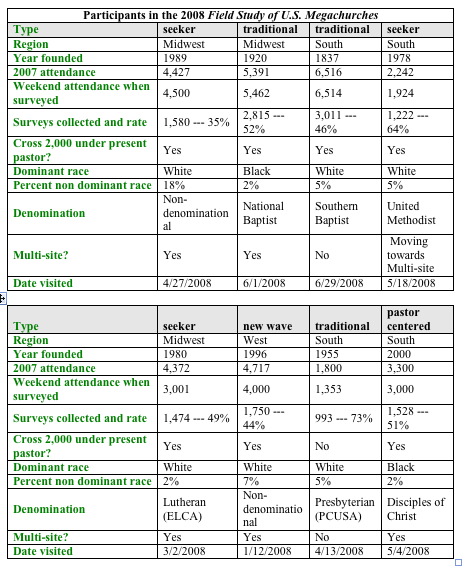
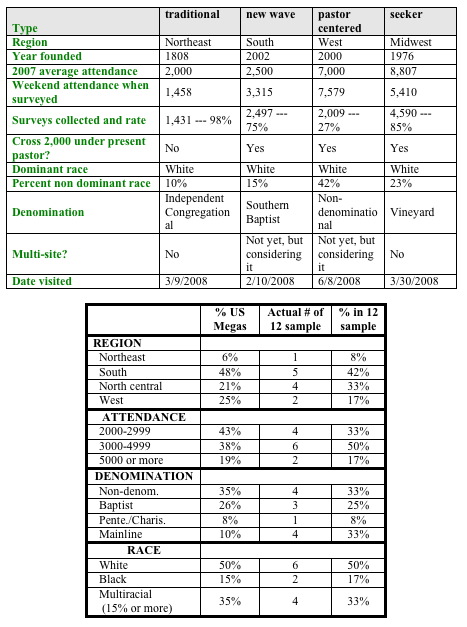

The total Field Study of U.S. Megachurches involved several activities as follows:
- On-site visits for first-hand observation, interviews and focus groups. 470 total interviews (352 in focus groups and 124 individual interviews) with recent attenders, long time attenders, key lay leaders and senior staff, plus individually with key staff and pastors.
- Staff survey with 718 completed surveys and 75% response rate.
- Ex-attender surveys - under 100 returned out of approximately 400 (35 or so distributed at each church)
- Participation in the Survey of North America's Largest Churches. The first public report was released September 2008, entitled Changes in American Megachurches. Subsequent special-topic reports will be titled American Megachurch Updates. Approximately 400 responses.
- Participation in an all-congregation survey. We asked each of the 12 participating churches to conduct an all-congregation survey of everyone age 18 and above. The survey was to take place at all services and all campuses on a weekend the church's leadership selected. A total of 24,900 attenders out of a total of 47,516 possible respondents participated.
- Comparison with other national surveys. A number of the questions in our congregational survey were worded to intentionally parallel questions in the Faith Communities Today 2008 Study, the U.S. Congregational Life Study currently in the field, and National Congregations Study Wave II. We will use these reports to make further comparisons and provide summary findings throughout 2009.
Comparison Study U. S. Congregational Life Survey (USCLS)
- Primary investigators – Cynthia Woolever and Deborah Bruce, through the
Presbyterian Church, USA research office.
- Project Website – www.USCongregations.org
- TOTAL – Random national survey of congregations of all sizes and traditions with average attendance 186; Done in 2001 (and being redone 2008-2009); Number of attenders – 122,404
- PROT – Protestant subset of USCLS - Only attenders in Protestant churches 18 years of age or older – 42,558

The study was made possible with the generous financial support from Leadership Network and tremendous assistance from Leadership Network staff Dave Travis, Stephanie Plagens, and Bonnie Randle, as well as a funded sabbatical from Hartford Seminary, and the tremendous patience and tolerance of our families.
For information on the national 2008 megachurch survey, see http://hirr.hartsem.edu/megachurch/megastoday2008_summaryreport.html.
For information on the national 2005 megachurch survey and its methodology, see http://hirr.hartsem.edu/megachurch/megastoday2005summaryreport.pdf
and http://hirr.hartsem.edu/megachurch/megastoday2005_method.html
For information on the national 2000 megachurch survey and its methodology, see http://hirr.hartsem.edu/megachurch/faith_megachurches_FACTsummary.html
This report was released on June 2009. Copyright 2009 by Leadership Network and Hartford Seminary.
If you have questions, please direct them to:
Scott Thumma
Hartford Institute for Religion Research
Hartford Seminary
77 Sherman Street
Hartford, CT 06105
sthumma@hartsem.edu |
Warren Bird
Leadership Network
2626 Cole Ave., Suite 900
Dallas, TX 75204
warren.bird@leadnet.org |
1 See several earlier national megachurch reports on the websites of Hartford Seminary’s Hartford Institute for Religion Research http://hirr.hartsem.edu/megachurch/megachurches.html and Leadership Network www.leadnet.org and Beyond Megachurch Myths by Scott Thumma and Dave Travis, Jossey Bass, 2007.
2 Here and elsewhere, in both the report and tables, percentages may not add up to exactly 100% due to rounding.
3 Parish Profile Inventory used by its Hartford Seminary’s Hartford Institute for Religion Research to assist churches in self-evaluation, see http://hirr.hartsem.edu/leadership/church_inventory.html for details of the survey and summary data from nearly 12,000 respondents.
|
